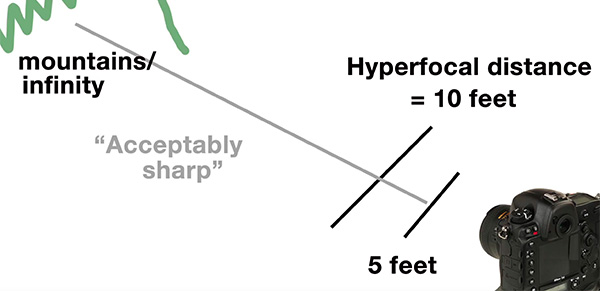Maximize your depth of field using the hyperfocal distance
posted Friday, March 11, 2016 at 3:35 PM EST

Photographer Barry O'Carroll put together an excellent tutorial aimed at landscape photographers covering hyperfocal distance and how to use it for capturing sharp images.
While hyperfocal distance can be calculated using formulas, Barry does a great job simplifying the concept and providing photographers with easy methods for calculating it for particular lenses and f/stops.
Firstly, what is the hyperfocal distance? Basically, the hyperfocal distance is the distance beyond which objects can be captured "acceptably sharp." It is worth noting that technically only objects on the actual focal plane will be in perfect focus, but objects outside of this plane will appear sharp.
To make this concept clearer, check out the diagram below. The actual hyperfocal distance in this example is 10 feet, but everything from halfway between the hyperfocal distance and the lens (5 feet in this case) to infinity will be "acceptably sharp." (Note: "Acceptably sharp" in this context essentially means that when viewing an image at a normal distance, objects within the halfway distance and infinity will appear to be in focus.)

Using the hyperfocal distance to focus for landscape images will maximize your depth of field and allow you to have both foreground and background subjects appear sharp. Using the hyperfocal distance is generally a good idea for landscape photography, but it is not always necessarily desired. For example, if you have a background with very little detail, you may want to focus closer than your hyperfocal distance as background sharpness is less important in this case.
Hyperfocal distance depends on many variables including the focal length, aperture, and camera used. So how do you calculate the hyperfocal distance? You could use the mathematical formulas found here…or you could use applications such as SetMyCamera for iOS or HyperFocal Pro for Android. There are also web-based calculators available.
Let's suppose that an application reports that your hyperfocal distance is 17 feet. You could bring a tape measure out into the field and be very precise, but Barry says that estimating often works well -- not to mention being much more practical! If your hyperfocal distance is close, you can manually focus your lens quite accurately, but this is harder at longer distances.

To sum it up, you should use hyperfocal distance for focusing landscape images because it's an accurate way to maximize your depth of field and it allows you to use your lens at its "sweet spot" aperture rather than stopping it all the way down and having to deal with diffraction. For much more detail and more reasons to use hyperfocal distance for focusing, see Barry O'Carroll's tutorial here.
Photographer Matt Granger has also put together a short video explaining hyperfocal distance in simple terms. Check that out below.
(Seen via reddit.)